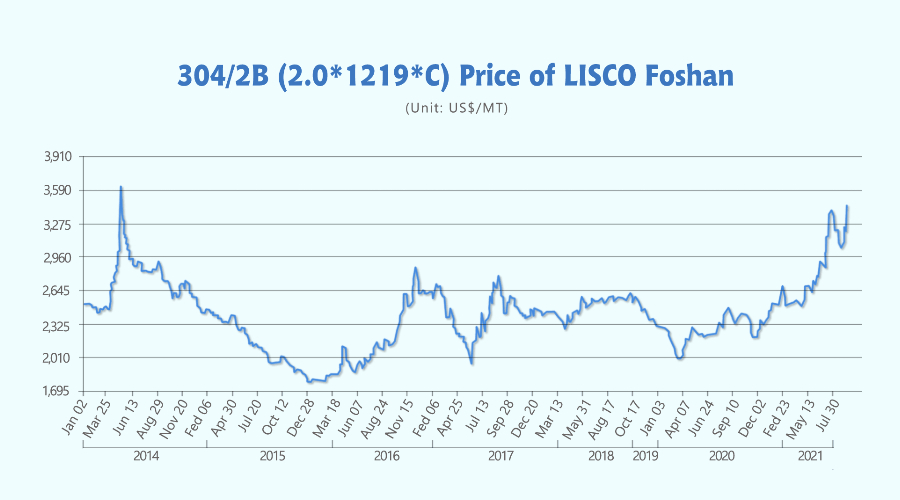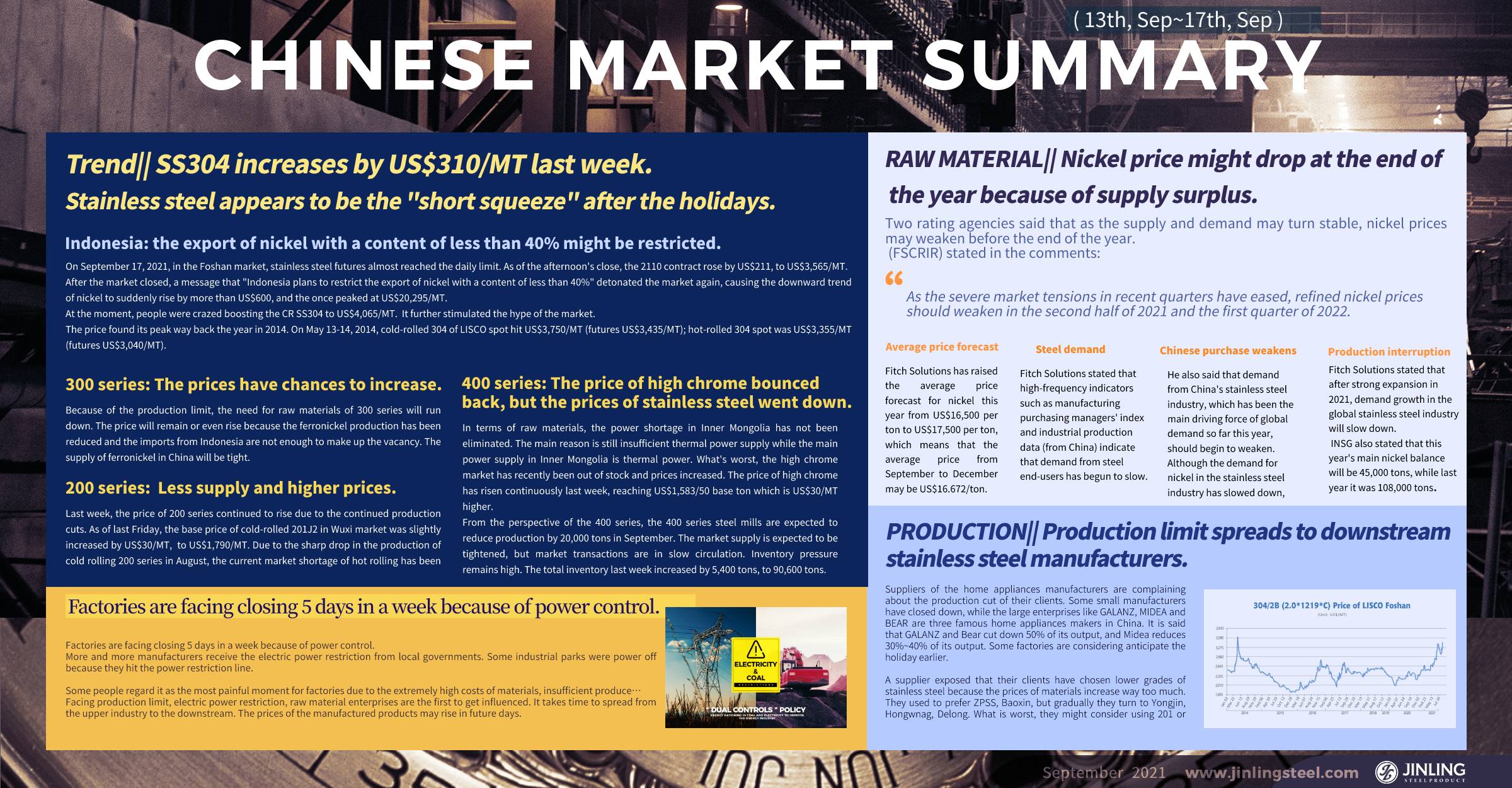Trend|| SS304 increases by US$310/MT last week. Stainless steel appears to be the "short squeeze" after the holidays.
Last week, the stainless steel futures and spot markets rose strongly. As of Friday's close (on September 17th), the stainless steel futures contract 2110 increased by US$343/MT, closed at US$3,200/MT during the week. In Wuxi market, cold-rolled SS304 by the private-owned mills have risen by US$313/MT last week, and the base price of private cold-rolled four-foot mill edge has risen to US$3,510/MT.
Indonesia: the export of nickel with a content of less than 40% might be restricted.
On September 17, 2021, in the Foshan market, stainless steel futures almost reached the daily limit. As of the afternoon's close, the 2110 contract rose by US$211, to US$3,565/MT.
After the market closed, a message that "Indonesia plans to restrict the export of nickel with a content of less than 40%" detonated the market again, causing the downward trend of nickel to suddenly rise by more than US$600, and the once peaked at US$20,295/MT.

At the moment, people were crazed boosting the CR SS304 to US$4,065/MT. It further stimulated the hype of the market.
The price found its peak way back the year in 2014. On May 13-14, 2014, cold-rolled 304 of LISCO spot hit US$3,750/MT (futures US$3,435/MT); hot-rolled 304 spot was US$3,355/MT (futures US$3,040/MT).
300 series: The prices have chances to increase.
In the current stainless steel market, the production limit is still the major booster for the price increase. Last week, a steel mill giant in Jiangsu has closed down three of four branches which include 12 production lines. About 10,000 ~ 20,000 tons of 300 series output will be influenced. Hot rolling, cold rolling, and pickling lines have all been discontinued. Guangxi Province is carrying severe power restrictions. The power consumption of Beigang New Materials in late September has dropped to 70%, which is expected to affect the output of 200 or 300 series of 40,000 to 50,000 tons. The production cuts of Guangqing will continue until the end of September, and no specific time is notified.
Because of the output reduction of steel mills, in September, the crude steel output of China's stainless steel flat steel manufacturers will decrease by 440,000 tons from August, lowering to 2.21 million tons. As for 300 series, the production will decrease to 1.09 million tons, which is 200,000 tons less than August.
From the perspective of futures, for now, the resources of warehouse warrants keep reducing. The position of contract 2110 is about 55,000 plots which are 2,500 plots more than last week. The demand for delivery is still large while the registered warehouse warrant volume is 12,500 tons. Affected by the festival in September and National Day in October, the register of the contract for October will be tight. If the supply of the warehouse warrant is insufficient, the futures prices will rise.
About the raw material, a steel mill in Eastern China made a 10,000-ton high nickel-iron deal at US$232/nickel. To stay in line with the energy consumption reduction, a ferronickel plant in Siqian stops all the production lines. In Eastern China, a steel mill also suspends 12 ferronickel production lines. Therefore, it is reasonable that in September, the supply of ferronickel will decline greatly.
As for the nickel ore, last week, the price slightly grew. Until the 18th, the CIF quotation of the Philippines nickel ore (1.5g/MT) was US$92/MT which increased by US$2 in a week. Currently, due to the production limit and electric power restriction in China, the demand for nickel ore is reducing. And the rainy season in The Philippines is on the corner, but the nickel ore circulated in China is inadequate. The supply of nickel ore will be tight but in a short term, the price remains stable.
Because of the production limit, the need for raw materials of 300 series will run down. The price will remain or even rise because the ferronickel production has been reduced and the imports from Indonesia are not enough to make up the vacancy. The supply of ferronickel in China will be tight.
What is uncertain?
1. From last week's inventory, the inventory of the 300 series increased by 12,600 tons, going up to 309,700 tons. During the price increase, the downstream purchases were not that into buying, and the market's sentiment was weak in chasing the prices up. Many of the sources of goods are concentrated in the circulation among intermediaries, and the inventory did not get cleared. Last week, Delong's distribution was significantly reduced. Only 1,000 tons were distributed on Thursday. Tsingshan and Beigang New Materials had new arrivals, which mainly was hot-rolled 304, about 20,000 tons.
2. At present, the profit of 300 series steel mills is close to US$470/MT, the price of SS304 in the last week hit a 7-year high. What's more important, it is not the cost that lifts the price of stainless steel, and the price of raw materials only rose slightly.
3. Looking at the macro side, the US Federal Open Market Committee (FOMC) holds a meeting on September 21-22. Fed officials may seek to reach an agreement at the upcoming September interest rate meeting to start reducing loose monetary policy in November. If the meeting releases come out with a tightening monetary decision, it will hurt the commodity market.
4. The Shanghai Futures Exchange announced on the 17th that the transaction fee for intraday closing of the stainless steel futures Ss2110 and Ss2111 contracts was adjusted to US$3 per lot. The exchange may introduce more price stabilization measures in the future.
200 series: Less supply and higher prices.
Last week, the inventory of the 200 series in Wuxi market increased slightly by 10,900 tons compared with a week ago, and the total inventory rose to 42,000 tons, which remained. Last week, the price of 200 series continued to rise due to the continued production cuts. As of last Friday, the base price of cold-rolled 201J2 in Wuxi market was slightly increased by US$30/MT, to US$1,790/MT. Due to the sharp drop in the production of cold rolling 200 series in August, the current market shortage of hot rolling has been significantly eased compared with the previous period. The price difference between CR and HR was reversed in August, and now the difference went normal and reaches US$47/MT.
In the short term, due to the dual control of energy consumption and environmental protection inspections, steel mills have implemented a production restriction plan. Steel mills such as Baosteel Desheng, Guangqing, SY, Beigang New Materials, HNJH and others have reduced the output of the 200 series. On the whole, the output of the 200 series in September decreased by 220,000 tons from August, reducing to 660,000 tons. The shortage of stock will gradually be reflected in the market in the future. It is expected that the prices will fluctuate next week, and the base price will increase by US$15-US$30/MT.
400 series: The price of high chrome bounced back, but the prices of stainless steel went down.
In terms of raw materials, the power shortage in Inner Mongolia has not been eliminated. The main reason is still insufficient thermal power supply while the main power supply in Inner Mongolia is thermal power. What's worst, the high chrome market has recently been out of stock and prices increased. The price of high chrome has risen continuously last week, reaching US$1,583/50 base ton which is US$30/MT higher.
From the perspective of the 400 series, the 400 series steel mills are expected to reduce production by 20,000 tons in September. The market supply is expected to be tightened, but market transactions are in slow circulation. Inventory pressure remains high. The total inventory last week increased by 5,400 tons, to 90,600 tons.
Summary:
304: With the production restriction and power restriction, the price of cold-rolled 304 is expected to run strongly next week. It is necessary to pay close attention to the situation of local production restriction and power restriction. And be cautious that the future demand cannot meet the increasing prices.
201: Supported by production cuts and low inventories, it is expected that the prices will be volatile next week, and the base price will increase by US$15-US$30/MT.
430: Under the influence of high inventory and weak transactions, the mainstream transaction prices of TISCO and JISCO 430/2B in the Wuxi market are expected to be slightly lowered to around US$1,805/MT~US$1,820/MT.
At the beginning of last week, the main stainless steel futures contract fell below US$3,115 under the influence of the spot downturn, and then the production restriction policies across the country increased again, and the disk continued to hit the daily limit, approaching US$3,590.
Stainless steel stock appears to be "short-squeeze". The contract 2110 holdings reached 55,000 lots, while the current stock on the Shanghai Futures Exchange is only more than 10,000 tons. The "short-squeeze" market will continue after the National holiday in October. The main reasons are as follows:
1. Under the influence of the stricter production restriction policy, steel mills have difficulty producing warehouse receipts. The marker is out of stock. What's worst, marine shipping has been tight recently. The imports of Indonesian semi-finished stainless steel products slow down, and the production of warehouse receipts is facing a shortage of materials;
2. Due to the long Mid-Autumn Festival and National holidays, there are fewer trading days for the delivery of the contract 2110, and the time for warehouse receipt registration is short.
3. Disturbed by Indonesia's restrictions on the export of ferronickel, concerns about the supply of raw materials are triggered in the market and push the market to continue to rise.
Under the current "short-squeeze", we need to focus on the changes in the contract 2110 's open interest. If there is a substantial reduction in positions, it means the "short-squeeze" comes to an end.
How the more severe restrictions on production will be reflected in the stock and the market? And whether the subsequent stainless steel stock market can maintain high prices again will be questionable.
4. As for the demand side, although prices continue to rise, market transactions have been cold, and high domestic prices have hit the price competitiveness of stainless steel exports in the fourth quarter. The weakening of demand will be a high probability event.
5. As for the supply side, in order to achieve the goal of production limit at the end of the year, the supply side has been reduced while also reducing the demand for the raw material side, and the cost is expected to fall. The profit margin of steel mills will expand, and price cuts will be adopted to promote sales.
Summary:
The short-selling of the stock market will continue until after the October festival, but from a realistic point of view, stainless steel has entered a weak situation of supply and demand. After the continuous surge, the stock market is expected to return to normal.
RAW MATERIAL|| Nickel price might drop at the end of the year because of supply surplus.
On September 21, it was revealed that from the second quarter of next year, interest rates may slow down at an accelerated rate.
Two rating agencies said that as the supply and demand may turn stable, nickel prices may weaken before the end of the year.
FSCRIR stated in the comments:
"As the severe market tensions in recent quarters have eased, refined nickel prices should weaken in the second half of 2021 and the first quarter of 2022."
"The high nickel prices in the first half of 2021 may ease in the next 12 months or so. The rate of interest rate slowdown may increase from the second quarter of 2022, as supply is expected to exceed the demand and it will become a surplus this year. , Not this year's marginal deficit", Kaushik Das of ICRA said.
Average price forecast
Fitch Solutions has raised the average price forecast for nickel this year from US$16,500 per ton to US$17,500 per ton, which means that the average price from September to December may be US$16.672/ton. However, the UK-based business intelligence company CRU Group believes that the price of the ruling company will continue until the end of the year.
Steel demand
FSCRIR: China's steel demand has grown rapidly in the first nine months of 2021, which indicates that the price trend is firm.
"Although it is reported that China's stainless steel production increased by 25% in the first half of this year, the production restriction measures taken to curb pollution before the Winter Olympics at the beginning of next year may result in weak growth throughout the year," said Das, and he pointed out that China accounted for nearly 60% of global stainless steel production last year.
Fitch Solutions stated that high-frequency indicators such as manufacturing purchasing managers' index and industrial production data (from China) indicate that demand from steel end-users has begun to slow.
Chinese purchase weakens
He also said that demand from China's stainless steel industry, which has been the main driving force of global demand so far this year, should begin to weaken.
Although the demand for nickel in the stainless steel industry has slowed down, the demand for the electric vehicle industry is still strong, supporting China's overall nickel demand.
Production interruption
Shah said that the epidemic has affected production, especially in Indonesia. Fortunately, most of the works has gone normal.
INSG expects this year's primary nickel production will increase from 2.49 million tons last year to 2.72 million tons.
Fitch Solutions stated that after strong expansion in 2021, demand growth in the global stainless steel industry will slow down.
INSG also stated that this year's main nickel balance will be 45,000 tons, while last year it was 108,000 tons.
PRODUCTION|| Production limit spreads to downstream stainless steel manufacturers.
Suppliers of the home appliances manufacturers are complaining about the production cut of their clients. Some small manufacturers have closed down, while the large enterprises like GALANZ, MIDEA and BEAR are three famous home appliances makers in China. It is said that GALANZ and Bear cut down 50% of its output, and Midea reduces 30%~40% of its output. Some factories are considering anticipate the holiday earlier.
A supplier exposed that their clients have chosen lower grades of stainless steel because the prices of materials increase way too much. They used to prefer ZPSS, Baoxin, but gradually they turn to Yongjin, Hongwnag, Delong. What is worst, they might consider using 201 or 430 to replace the previous materials.
Factories are facing closing 5 days in a week because of power control.

The policy can be traced back to March this year.
More and more manufacturers receive the electric power restriction from local governments. Some industrial parks were power off because they hit the power restriction line.
Some people regard it as the most painful moment for factories due to the extremely high costs of materials, insufficient produce…
Facing production limit, electric power restriction, raw material enterprises are the first to get influenced. It takes time to spread from the upper industry to the downstream. The prices of the manufactured products may rise in future days.
Stainless Steel Market Summary in ChinaStainless Steel Market Summary in ChinaStainless Steel Market Summary in ChinaStainless Steel Market Summary in China
